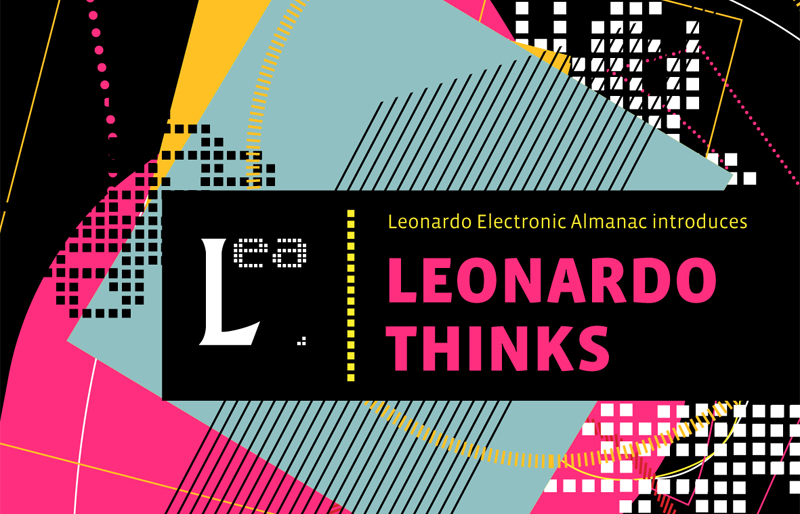
LEONARDO THINKS 1968 – 2012
Contemporary Opinion by David Burraston
David Burraston proposes that creativity and complexity, as a combined endeavour with methodological rigour, has the potential to make our current and precarious game of life a win-win situation.
Creativity + Complexity = Win Win
A couple in love walking along the banks of the Seine are, in real fact, a couple in love walking along the banks of the Seine, not mere particles in motion. Stuart Kauffman [1]
The game of real life is many things; beautiful, complex, horrific and increasingly precarious. But the rules of the game are far from being completely understood. As a field of scientific endeavour, complex systems science offers the hope of better understanding ourselves and the world around us, and producing major advances towards solving some of the worlds key environmental, cultural and social problems. The problems addressed by complex systems are recognized as being hard, as evidenced by the limitations in reductionist science to make significant advances. This is a well known problem, and Melanie Mitchell states it succinctly [2]:
In spite of its great successes explaining the very large and very small, fundamental physics, and more generally, scientific reductionism, have been notably mute in explaining the complex phenomena closest to our human-scale concerns.
Complex systems is an emerging multidisciplinary science developing new ways of researching large, highly intricate, dynamical systems in diverse areas such as biology, physics, social networks, socio-technological systems, socio-ecological systems, economics, our environment, the list goes on… [1, 2, 3, 4]. The use of complex systems and creativity, especially in music [5] and art [6] certainly has a history. So why is what I am proposing different? Put simply, it is a tale of two outcomes where art and science are a truly unified practice.
What C+C=WW proposes is broad and deep research focused on a plurality of outcomes (knowledge and artefact, perhaps embedded in the same “object”) using robust methodologies. I have developed a methodology for my own knowledge making and artistic creation [7, 8], but this is not meant to be a prescription for others, although hopefully an inspiration. A web page on my blog supplements this article with more details and references [9].
In my experience, art and science as described above is a win-win scenario. The production of both successful artworks and fundamental research has a clear benefit, where art/science research is a two-way street. Technology and science are useful tools for the creative, but by the same token, the creative process is equally beneficial for driving innovation, whether scientific or technological. As Peter Cochrane puts it [10] :
Industries of the past were about process, about constrained problem-solving in a slow-moving world. But that time is long gone, and today’s companies have to deal with fast-moving technology and competition, and that demands creativity and unbounded thinking.
Great, where can I go to get involved in this exciting new and bold frontier? That’s the catch, where can you go? Apart from a small, but thankfully growing number of forward thinking and forward looking organisations, the cupboard is still pretty bare (though not completely empty). The present situation is summed up nicely by Stuart Kauffman [11] :
The two cultures, science and humanities, remain firmly un-united.
Clearly though, there are people out there doing this kind of art and science, but it is still a minority sport. This situation has to change, and should be the norm rather than the exception. My assertion is that creativity and complexity, as a combined endeavour with methodological rigour, has the potential to make our current and precarious game of life a win-win situation. It is high time for the two cultures to really unite; to play and win the game. Don’t let the reductionists grind you down!
Endnotes
[1] Kauffman, S. A. Reinventing the Sacred: A New View Of Science, Reason, and Religion, (NY: Basic Books, 2008).
[2] Mitchell, M. Complexity: A Guided Tour, (Oxford University Press, 2009).
[3] J. Norberg and G. Cumming, Complexity Theory for a Sustainable Future, (Columbia University Press, 2008).
[4] Crutchfield, J. P., The Hidden Fragility of Complex Systems – Consequences of Change, Changing Consequences, in Cultures of Change: Social Atoms and Electronic Lives, edited by G. Ascione, C. Massip, and J. Perello, (Barcelona, Spain : ACTAR D Publishers, 2009), 98-111.
[5] Burraston, D. and Edmonds, E., “Cellular Automata in Generative Electronic Music and Sonic Art: A Historical and Technical Review,” Digital Creativity 16 no: 3 (2005), 165-185.
[6] Edmonds, E., Brown, P. and Burraston, D. (Eds), Generative Arts Practice. Proceedings of Generative Arts Practice Symposium, (Creativity & Cognition Studios Press, 2005).
[7] Burraston, D., “Creativity, Complexity and Reflective Practice,” in Interacting: Art, Research and the Creative Practitioner, eds. Candy, L. and Edmonds, E., (Oxford: Libri Publishing Ltd., 2011).
[8] Burraston, D. “Fundamental Insights on Complex Systems arising from Generative Arts Practice,” Leonardo Vol 40 (4), (MIT Press, 2007).
[9] Burraston, D., “Creativity + Complexity: Don’t Let The Reductionists Grind You Down!,” 2012, http://noyzelab.blogspot.com/2012/01/creativity-complexity-dont-let_30.html (accessed February 2012).
[10] Cochrane, P., “Educational priesthood’s credo is killing innovation”, 2011, http://www.silicon.com/management/public-sector/2011/08/08/peter-cochranes-blog-educational-priesthoods-credo-is-killing-innovation-39747772/ (accessed February 2012).
[11] Kauffman, S (2006) “Beyond Reductionism: Reinventing The Sacred,” 2006, http://edge.org/conversation/beyond-reductionism-reinventing-the-sacred (accessed February 2012).
David Burraston is an artist/scientist working in the area of creative practice and complex systems. He has been operating Noyzelab as an independant art/science music studio since 1981 and is a Director of The WIRED Lab. His email is dave@noyzelab.com. More information about his work is available at http://www.noyzelab.com
ISSN No: 1071-4391
Author: David Burraston, E-mail: dave@noyzelab.com
Director of The WIRED Lab
Invited Leonardo Thinks Essay
Leonardo is a registered trademark of the ISAST.
